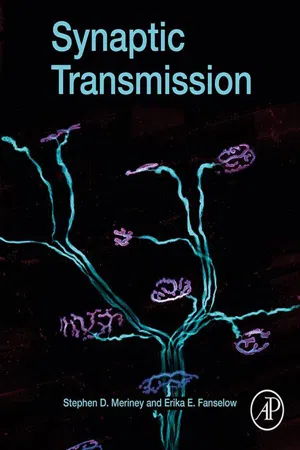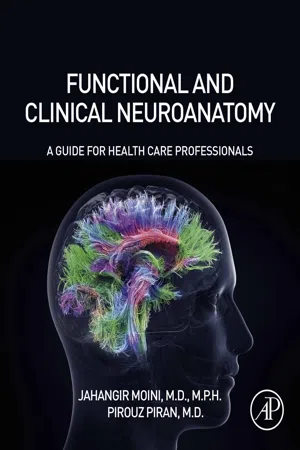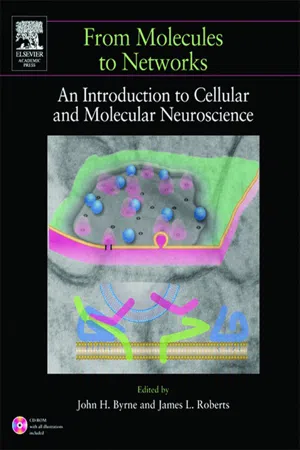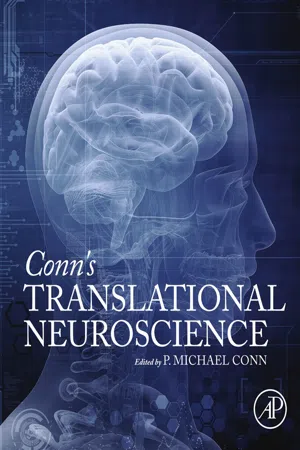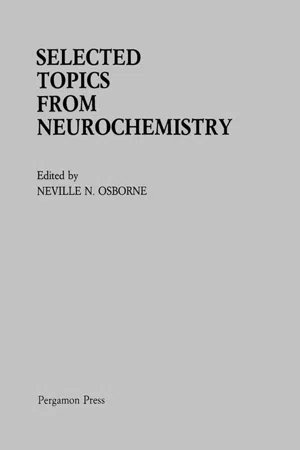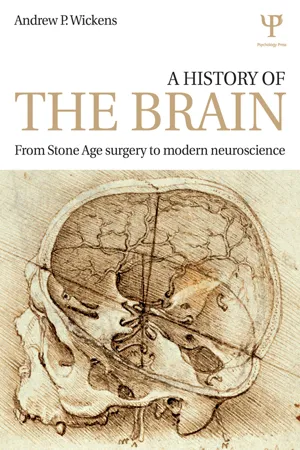Psychology
Neurotransmitters
Neurotransmitters are chemical messengers that transmit signals across the synapses between neurons. They play a crucial role in regulating various physiological and psychological processes, including mood, memory, and behavior. Imbalances in neurotransmitter levels have been linked to various mental health conditions, making them a key focus in understanding and treating psychological disorders.
Written by Perlego with AI-assistance
Related key terms
Related key terms
1 of 4
Related key terms
1 of 3
10 Key excerpts on "Neurotransmitters"
- eBook - ePub
Brain, Attachment, Personality
An Introduction to Neuroaffective Development
- Susan Hart(Author)
- 2018(Publication Date)
- Routledge(Publisher)
In the general debate, the Neurotransmitters are most commonly mentioned in connection with psychoactive medication (for example Prozac, Ritalin, etc.), and much research in the pharmaceutical industry is aimed at influencing and regulating affective conditions by chemical means. To anyone outside the health professions, the explanations can be almost impossible to grasp, and in this chapter I attempt to describe the most common Neurotransmitters in a way that, I hope, will make this knowledge somewhat more accessible and offer some insight into the ways that affective states are influenced by the distribution of biochemical substances.Neurotransmitters, peptides, and hormones act as chemical substances throughout the brain and are transmitted through neuronal synapses (see Figures 3.5 and 3.6 ). The neurochemicals are vastly important to practically all the processes that take place within the organism. In relation to affects, these substances affect our moods, motivation, attention functions, etc. All Neurotransmitters, peptides, and hormones have a synaptic language that transmits specific types of electric or chemical messages; some types inhibit, while others induce, certain tendencies in psychological behaviour. Most neurons contain different types of molecules, which means that they can be activated by different Neurotransmitters. However, each neuron has one primary neurotransmitter. Neurotransmitters are neurochemicals that are released from neurons in the brainstem and released in the synapses. Hormones are neurochemicals that are transported via the bloodstream and released from the adrenocortical glands, the hypothalamus, the pituitary gland, the sexual organs, and other sources. Typically, they do not respond as quickly as the Neurotransmitters. Peptides are made from amino acids and may function both as Neurotransmitters and as hormones. Their function is to intensify and to modulate the effect of the Neurotransmitters (Table 9.1 - eBook - ePub
- Stephen D. Meriney, Erika Fanselow(Authors)
- 2019(Publication Date)
- Academic Press(Publisher)
20 , it will become clear that the criteria listed above often do not hold true for all Neurotransmitters. More and more chemicals have been identified in the nervous system that appear to serve as Neurotransmitters, and their diversity makes it very difficult to identify a single, definitive list of properties that define a chemical as a neurotransmitter. A more inclusive definition of a neurotransmitter might be as broad as “A chemical substance that conveys information between cells in the nervous system.”It is also important to note that the same molecules that we might define as Neurotransmitters based on their actions in the nervous system may also be used by other tissues in the body (e.g., the endocrine system) as nonsynaptic intercellular messengers. As a result, some of the chemical Neurotransmitters discussed in the chapters that follow have important roles in other systems as well.For some candidate Neurotransmitters, it is not entirely straightforward to test all six of the listed criteria. This can be due to limitations in available experimental techniques and/or a lack of tractable experimental preparations. For example, the amount of neurotransmitter released at some synapses can be quite small, typically ~10,000 molecules of neurotransmitter per action potential. This sounds like a large number, but it can be difficult to detect thousands of a specific type of molecule in a vast extracellular space that contains many millions of other molecules. Additionally, the anatomy of the nervous system makes investigating neurotransmitter molecules difficult because it is rare for homogeneous groups of a specific type of neuron to be anatomically separated from other types of neurons. As a result, it can be challenging to specifically stimulate only one neuron and to selectively record the postsynaptic effect of such stimulation. This difficulty is especially prevalent in the central nervous system, particularly in regions that receive input from many types of neurons, such as in the hippocampus and the neocortex. In the hippocampus, a single neuron can receive thousands of synaptic inputs, and these may not each release the same transmitter molecules. In fact, many Neurotransmitters were first identified at peripheral synapses, which are often larger in size, and can be more readily isolated from other types of neurons. This is one of the reasons specialized experimental preparations such as the neuromuscular junction have been, and still are, so critical for learning about synapses and Neurotransmitters. - eBook - ePub
Functional and Clinical Neuroanatomy
A Guide for Health Care Professionals
- Jahangir Moini, Pirouz Piran(Authors)
- 2020(Publication Date)
- Academic Press(Publisher)
Chapter 18 Neurotransmitters Abstract Neurotransmitters are molecules that carry along with electrical signals and may amplify signals between nerves and other nerves, or between nerves and other cell types. They affect many different functions, including our thoughts, emotions, memoires, movements, and sleep patterns. Synaptic transmission is primarily affected by enhancing or inhibiting neurotransmitter release, destruction, reabsorption, as well as by blocking neurotransmitter binding to receptors. Neurotransmitters are often amino acids, small peptides, or derivative chemicals. The classic Neurotransmitters include acetylcholine (ACh), dopamine, gamma-aminobutyric acid (GABA), glutamine, norepinephrine (NE), serotonin, and others. More than 50 Neurotransmitters, or potential Neurotransmitters, have been identified. Keywords Neurotransmitters; Acetylcholine; Neuromodulators; Schizophrenia; Purines; Amino acids Neurotransmitters are molecules that, along with electrical signals, carry and may amplify signals between nerves and other nerves, or between nerves and other cell types. They affect many different functions, including our thoughts, emotions, memoires, movements, and sleep patterns. Synaptic transmission is primarily affected by enhancing or inhibiting neurotransmitter release, destruction, reabsorption, as well as by blocking neurotransmitter binding to receptors. Neurotransmitters are often amino acids, small peptides, or derivative chemicals. The classic Neurotransmitters include acetylcholine (ACh), dopamine, gamma-aminobutyric acid (GABA), glutamine, norepinephrine (NE), serotonin, and others - eBook - ePub
From Molecules to Networks
An Introduction to Cellular and Molecular Neuroscience
- John H. Byrne, Ruth Heidelberger, M. Neal Waxham, James L. Roberts(Authors)
- 2003(Publication Date)
- Academic Press(Publisher)
Chemically mediated transmission is the major means by which a signal is communicated from one nerve cell to another, and is the mode of neuronal communication on which this and the next chapter focus. The general acceptance of chemical communication between neurons as the dominant mode of signaling required that certain criteria be met for a compound to be accepted as a neurotransmitter. These “classic” criteria for transmitters have resulted in a relatively small number of compounds being recognized as “classic” transmitters. However, over the past generation it has become apparent that there are an even larger number of chemical messengers that broadly qualify as intercellular transmitters, although these often do not meet (and indeed serve as exceptions) the classic criteria.The Criteria for Definition as a Neurotransmitter
Neurotransmitters are endogenous substances that are released from neurons, act on receptor sites that are typically present on membranes of postsynaptic cells, and produce a functional change in the properties of the target cell. Over the years there has been general agreement that several criteria should be met before a substance can be designated a neurotransmitter.First, a neurotransmitter must be synthesized by and released from neurons. In many cases, this means that the presynaptic neuron should contain a transmitter and the appropriate enzymes required for synthesis of that neurotransmitter. However, synthesis in the nerve terminal is not an absolute requirement. For example, peptide transmitters are synthesized in the cell body and transported to distant sites, where they are released (see Chapter 10 ).Second, the substance should be released from nerve terminals in a chemically or pharmacologically identifiable form. Thus, one should be able to isolate the transmitter and characterize its structure using biochemical or other techniques. - eBook - ePub
- Gail Anderson(Author)
- 2019(Publication Date)
- CRC Press(Publisher)
Of course, this only describes communication between two cells. For a message to get from the brain, say to move one’s hand, millions of cells must communicate (involving countless Neurotransmitters) in a split second.The chemicals that do the transmitting are called Neurotransmitters, and they are stored in sacs called synaptic vesicles. Many Neurotransmitters are known, including amino acids and biogenic amines. We are most interested here in the amines—which include such basic Neurotransmitters as dopamine, norepinephrine, and serotonin—because they are the basis for information processing and communication in the human brain. As a result, they are the basis of almost all behavior, from sensation (the ability to touch and feel) to perception, learning, memory, eating and drinking, and, more controversially, antisocial behavior. As they are produced and discharged into the cleft, these Neurotransmitters transmit information throughout the brain. All three of these Neurotransmitters are thought to be very important in the context of brain behavior.Both medical diagnoses and research into criminogenic behavior need to measure the levels of these Neurotransmitters in the central nervous system. There are several methods used. Neurotransmitters are made of precursors that are the basic proteins of life, amino acids. Each neurotransmitter has a particular amino acid precursor, which is synthesized to make the neurotransmitter. Moreover, there is a particular enzyme that catalyzes that reaction to convert the amino acid into a neurotransmitter. It then must bind to receptors. Once the neurotransmitter has done its job, it breaks down into its metabolites. There are sometimes other chemicals that fluctuate with the neurotransmitter, so they can tell us the levels of the Neurotransmitters indirectly. You can measure any one of these elements in the chemical process (the precursor, the enzyme, the metabolites, or an indirect indicator) to get the levels of the neurotransmitter. The best method seems to be measuring the metabolites.2 - eBook - ePub
- Vincent Geenen(Author)
- 2004(Publication Date)
- CRC Press(Publisher)
I. WHAT IS A NEUROTRANSMITTER?
A substance is conventionally viewed as a neurotransmitter if the following criteria are met:- It is synthesized in neurons.
- It is present in the presynaptic nerve terminal and is released in amounts sufficient to exert a defined action on the postsynaptic neuron or effector organs.
- When administered exogenously (as a drug) in reasonable concentrations, it precisely mimics the action of the endogenously released neurotransmitter (e.g., it activates the same ion channels or second messenger pathway in the postsynaptic cell).
- A specific mechanism exists for its removal from its site of action (the synaptic cleft).
- Amino acids, among them glutamate, glycine, and γ-aminobutyric acid (GABA).
- Biogenic amines, among them dopamine, norepinephrine, epinephrine, and serotonin.
- Neuropeptides, among them somatostatin, substance P, vasoactive intestinal polypeptide (VIP), neuropeptide Y, NPY opioids, gonadotropin releasing hormone (GnRH), TRH, neurotensin, CRH, bombasin, prolactin, galanin, motilin, and many others.
Neurotransmitters exert either excitatory or inhibitory effects on their targets within the nervous system and have a very wide spectrum of activities via which they affect a kaleidoscope of body functions.II. WHERE CAN T CELLS “MEET” Neurotransmitters?
In principle, T cells may encounter Neurotransmitters at sites where they patrol or reside under physiological and pathological conditions. Specifically, T cells may be exposed to Neurotransmitters in the brain, lymphoid organs, other innervated peripheral organs, and the blood.Recent data indicate that the cellular sources of the Neurotransmitters are clearly not only neuronal but also immune, since lymphocytes produce and secrete various Neurotransmitters although in very low concentrations. This suggests that Neurotransmitters may have the ability to stimulate T cells in a paracrine or autocrine fashion. The different T cellular sources for Neurotransmitters and their relevance to Neurotransmitters–T-cellinteractions will be further discussed in the following sections. - eBook - ePub
- P. Michael Conn(Author)
- 2016(Publication Date)
- Academic Press(Publisher)
Chapter 3Neurotransmitters and Neurotransmission in the Developing and Adult Nervous System
S.L. Miller, and H.H. Yeh The Geisel School of Medicine at Dartmouth College, Lebanon, NH, United StatesAbstract
Chemical neurotransmission requires the coordination of pre- and postsynaptic events across the nervous system. Following action potential generation, large quantities of Neurotransmitters are released into the synaptic compartment. For most Neurotransmitters, the response they elicit within the postsynaptic cell occurs through two general mechanisms: a fast mechanism mediated by ionotropic receptors and a slow mechanism mediated by metabotropic receptors. These receptors, present at pre- and postsynaptic sites, are what dictate the actions of the neurotransmitter. Receptor location, stability in the plasma membrane, their subunit composition, and posttranslational modifications, all dynamically regulate the response due to neurotransmitter binding throughout development. This chapter reviews the basic steps and concepts involved in neurotransmission to lay a foundation for understanding and interpreting the actions of well-known Neurotransmitters. We also include a section on the role of glia in the regulation of chemical neurotransmission in the brain.Keywords
Acetylcholine; Endocannabinoids; Gamma-aminobutyric acid; Glia; Glutamate; Muscarinic; Neurotransmission; Neurotransmitter; Nicotinic; SynapseIntroduction
Neurotransmitters shape the structure and function of the nervous system throughout life. Although not always the case, Neurotransmitters typically elicit their response upon their effector cells via the process known as synaptic transmission. This fundamental concept of chemical transmission across the synapse as the principle mode of communication among neurons is relatively new. It was not until the Greek philosopher, Alcmaeon of Croton (Fig. 3.1 ), in 5th century BC proposed that the brain is the house of the mind and soul that scholars began to question the concept that the mind is contained within the heart. Alcmaeon was also the first to propose the concept of the animal spirit. Through dissection and the investigation of blood vessels, he posited that, like arteries and veins that contained oxygenated and deoxygenated blood, respectively, nerves must be hollow structures that contained a substance necessary to produce movement that he and others called the animal spirit. Although definitive evidence for the existence of the animal spirit was never provided for well over 2000 - eBook - ePub
- Joaquin Fuster(Author)
- 2015(Publication Date)
- Academic Press(Publisher)
2+ promotes the release (exocytosis) of a neurotransmitter substance from the synaptic vesicles of the presynaptic membrane into the extraneuronal synaptic space. Thereupon, specific receptors, which are made of proteins in the postsynaptic membrane, recognize and incorporate the transmitter or ligand into their structure. This alters membrane ion permeability, membrane potential, and metabolism in the postsynaptic neuron, frequently through the intervention of second messengers such as cyclic adenosine monophosphate (cAMP). The cumulative effect of such changes (from repeated presynaptic action potentials) is to modify the firing rate of the postsynaptic neuron. By virtue of enzymatic reactions and servomechanisms, including chemical feedback to the presynaptic membrane and its specialized receptors (e.g., autoreceptors), the neurotransmitter remaining in the extraneuronal space is inactivated or taken up by the presynaptic terminal, and both the production and the transsynaptic effects of the neurotransmitter are momentarily arrested. The entire process unleashed by a single action potential is extremely rapid, sometimes on the sub-millisecond time-scale.Although the designation “neurotransmitter” is used in this chapter generically for all chemical transmitter substances, in recent years and especially in the context of prefrontal physiology, the distinction has been made between Neurotransmitters proper and neuromodulators. Glutamate and γ-aminobutyric acid (GABA) are included among the first, which are characterized by rapid effects on the ion channels that mediate transmission. For example, glutaminergic pyramidal cells of the prefrontal cortex engage in rapid, persistent activity during working memory, while GABAergic neurons help to tune the network’s firing by inhibiting responses to irrelevant stimuli and memories (Rao et al., 2000 ). Neuromodulators, on the other hand, include most other transmitters (monoamines, acetylcholine, etc., and sometimes also glutamate and GABA when they act on certain receptors). They are relatively slow acting and often involved in changes of general state (e.g., between sleep and wakefulness) or reward value.Neurotransmitters are produced within the body of the nerve cell and transported along the axon to its terminal synaptic vesicles, which in some cases are considerably remote from the soma; for example, catecholamine transmitters generated in certain cells of the lower brainstem are conveyed all the way to the cortex by the axons of those cells. The rate of neurotransmitter synthesis within a given cell is subject to a variety of metabolic factors, but the level of the substance at the terminals is kept relatively constant. Numerous chemical substances, however, can modify that level and, more generally, modify synaptic transmission by acting on one or more of the six successive steps that any given neurotransmitter undergoes. These steps are the following: (1) biosynthesis in the presynaptic neuron; (2) storage in synaptic vesicles; (3) release into the synaptic cleft; (4) binding and recognition by target receptors; (5) reuptake; and (6) metabolic inactivation. Figure 3.1 - eBook - ePub
- Neville N. Osborne(Author)
- 2013(Publication Date)
- Pergamon(Publisher)
In his review of the evolution and status of the concept of chemical synaptic transmission, Neville Osborne especially attends to the possibility that one neurone can synthesize more than one transmitter substance. He restricts his approach to the still prevailing notion that the important questions are (1) does information transmission involve chemically mediated alteration of postsynaptic excitability; (2) if so, what is the transmitter involved (and by what criteria can a substance be identified as a transmitter substance); (3) which chemical pathway(s) lead(s) to its synthesis; (4) where and by what mechanism is the transmitter released; (5) what is the fate of the released transmitter (enzymatic inactivation, reuptake, removal by diffusion) and, finally, (6) what are the biochemical and biophysical processes effected by the transmitter?Neuropharmacologists, by and large, have taken a similar view of the problem of chemical synaptic transmission and have investigated the mechanism of action of substances which, in one way or another, affect biochemical and biophysical processes involved in transmitter synthesis, release action and removal.My critique is not directed against this perfectly valid approach to chemical (synaptic) transmission; instead, I take issue with the notion that this set of questions is adequate and sufficient for reaching a satisfactory understanding of the functional role of chemical synaptic transmission.There is no doubt that synapses are relay stations which convey information from one neuron to another cell. There is also no question that synapses in which each presynaptic impulse sets up a propagated action potential in the postsynaptic cell are the exception rather than the rule and that there is a great variety of synapses (including all those commonly referred to as inhibitory synapses) which simply generate more or less graded postsynaptic potentials. - eBook - ePub
A History of the Brain
From Stone Age surgery to modern neuroscience
- Andrew P. Wickens(Author)
- 2014(Publication Date)
- Psychology Press(Publisher)
12THE DISCOVERY OF CHEMICAL NEUROTRANSMISSIONAdrenaline might then be the chemical stimulant liberated on each occasion when the impulse arrives at the periphery .Thomas Renton ElliottA remarkable conversion indeed. One is reminded almost inevitably of Saul on his way to Damascus when the sudden light shone and the scales fell from his eyes .Henry Hallett DaleSummaryArguably, the greatest advance in understanding how the nervous system works during the twentieth century was the establishment of chemical neurotransmission. This discovery not only led to the realisation the brain is awash with a great variety of Neurotransmitters, but also resulted in the introduction of the first antipsychotic and antidepressant drugs during the 1950s. It was a moment when progress in neuropharmacology can be said to have changed our world for ever. This situation, however, could have hardly been foreseen at the turn of the century. Although the synapse had been identified by Cajal, and the possibility of chemical communication speculated upon as early as 1878, the electrical option remained more plausible. After all, the electrical signal only had the smallest of distances to travel between nerve cells, and even if some power was dissipated in transit, it presumably could be regenerated again upon reaching the next cell. In contrast, chemical transmission appeared to be too slow and complex. Yet, over the coming years it would be the chemical theory that gained support, especially when investigators began to discover drugs that produced actions on the body closely mimicking nervous stimulation. This led to an extension of the neurotransmitter concept in 1905, when Cambridge professor John Langley proposed the existence of specialised receptors for adrenaline in the sympathetic nervous system. A decade later, the existence of receptors was established beyond reasonable doubt when Henry Dale identified separate nicotinic and muscarinic sites for acetylcholine throughout the body. However, the most vivid demonstration of neurotransmission was provided in 1920 when the Austrian Otto Loewi performed a classic experiment on the frog heart, showing the vagus nerve to secrete a chemical that slowed its beat (this later turned out to be acetylcholine). Despite this, many researchers, including the outspoken and forthright Australian John Eccles, were unwilling to broaden chemical neurotransmission to the brain and spinal cord. It was a situation, now known as the soup and sparks controversy, that caused much heated debate and consternation among the delegates of academic meetings and conferences, especially in the years following the Second World War. However, the issue was decisively settled in 1952 when Eccles was forced to admit, after performing the crucial experiment himself, that chemical transmission did indeed take place in the central nervous system. From this moment onwards, investigators would begin to look for Neurotransmitters afresh in the brain and map out their pathways, opening up many new avenues of research in pharmacology and neuroscience.
Index pages curate the most relevant extracts from our library of academic textbooks. They’ve been created using an in-house natural language model (NLM), each adding context and meaning to key research topics.
Explore more topic indexes
Explore more topic indexes
1 of 6
Explore more topic indexes
1 of 4

